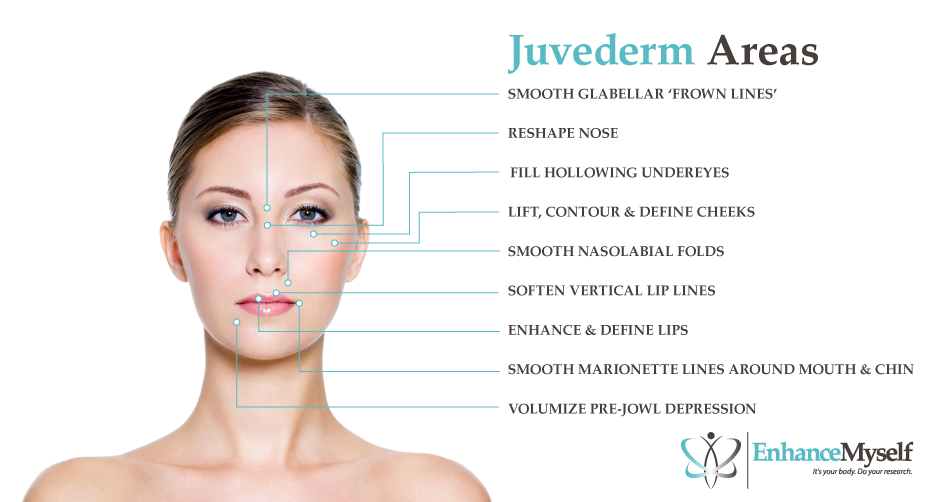Juvederm
-
 Content written by Karen Vieira, PhD MSM | Reviewed by EnhanceMyself Medical Team | Last updated 6/22/2023
Content written by Karen Vieira, PhD MSM | Reviewed by EnhanceMyself Medical Team | Last updated 6/22/2023 - Overview
Overview
What is Juvederm?
Juvederm is a line of dermal fillers, based on the natural biological compound hyaluronic acid. Juvederm fillers are injected under the skin of the face by trained medical professionals to treat the effects of aging, as a safe and effective alternative to surgery.
Topics covered on this page
- Cost of Juvederm injections
- Types of Juvederm products
- Areas commonly treated
- How it works
- Benefits of Juvederm
- Treatment details
- Safety information
- Healing time
- When to expect results
- How long does Juvederm last?
- Tips for choosing a provider
Cost of Juvederm injections
 The average cost of Juvederm is approximately $500 to $800 per syringe. The total cost of your treatment will depend on a number of factors such as:
The average cost of Juvederm is approximately $500 to $800 per syringe. The total cost of your treatment will depend on a number of factors such as:
- Your Provider: The experience of the healthcare provider will impact the cost. Highly skilled providers might charge more for their services.
- Type of Clinic: The kind of clinic where you get your treatment can affect the cost. Upscale clinics that offer additional amenities often have higher fees.
- Location Matters: Where you’re located matters. Different regions, cities have different price tags. Generally, bigger cities and more affluent areas tend to have higher prices.
- Type of Juvederm Product: Juvederm offers a range of products designed to address different concerns, such as volumizing the lips, filling in lines and wrinkles, or enhancing facial contours. The cost may vary depending on the specific Juvederm product used for your treatment.
- Number of Syringes: The amount of Juvederm needed for your treatment will impact the cost. One or two syringes are usually all that’s needed to treat a single area, but some patients may require 3 or 4. The number of syringes required will depend on the treatment area, the severity of the concerns being addressed, and your individual goals. More significant corrections or multiple treatment areas may require additional syringes.
- Additional Treatments: Juvederm can be combined with other dermal fillers or laser treatments which could increase your overall cost.
It’s important to consult with a qualified Juvederm provider who can provide a detailed breakdown of the expenses involved, tailored to your individual needs.
Types of Juvederm products
Juvederm is an entire line of products, each designed with different characteristics to make them especially well-suited for specific areas of the face and specific skin problems. Since most people seeking facial rejuvenation wish to address various area of the face, combined treatments with different products may be appropriate, and the filler products may be seen as being complementary to each other.
Many of the Juvederm products come in two versions, one of which contains the initial “XC” (such as Juvederm Volbella and Volbella XC). The XC means that the anesthetic numbing agent lidocaine is mixed in with the product for added comfort during the treatment. Most of the products are available in the XC version.
Some of the more popular formulations include:
- Juvederm Voluma XC: Injections beneath the surface of the skin add lift and contour to the cheeks to correct age-related volume loss. Average cost is $800 per syringe.
- Juvederm XC: Reduces smile lines and wrinkles around the mouth and nose. Results are immediate and can last up to a year. Average cost is $500 per syringe.
- Juvederm Vollure XC: Like Juvederm XC, Vollure XC targets moderate to severe smile lines around the mouth and nose. In addition to smoothing the area, Vollure XC also adds volume and can last up to 18 months. Average cost is $750 per syringe.
- Juvederm Ultra XC: Adds volume and fullness to the lips for a plump, youthful appearance. Average cost is $650 per syringe.
- Juvederm Volbella XC: Like Ultra XC, Volbella XC targets thin lips adding volume. Volbella XC has the added benefit of smoothing the appearance of vertical lines in the lips. Average cost is $750 per syringe.
Your healthcare provider will help you come up with a treatment plan with the best product for you based on your specific needs and goals. The best kinds of providers for this treatment are dermatologists, plastic surgeons, or facial plastic surgeons.
Areas commonly treated
Some common areas treated include:
- Mid-face
- Cheeks (e.g. cheek augmentations)
- Under eyes
- Nose
- Nasolabial folds
- Lips (e.g. lip augmentations)
- Smile Lines
- Chin
- Jawline
How it works
Juvederm uses the compound hyaluronic acid (HA) as its active ingredient. Hyaluronic acid is a natural protein found throughout our body, with important functions in keeping our skin healthy and robust. Other hyaluronic acid based fillers include Belotero and Restylane injections.
As we age, the collagen and elastin that provide the support structure of our skin and which are responsible for the suppleness and elasticity of our skin lose their connections and become disorganized and dried out. This gives skin the baggy, wrinkled, and dry appearance that we know as aging changes. However, HA – the active ingredient in Juvederm – stabilizes these important skin support structures and provides them with the proper chemical environment to reconnect and regain their important functions again.
This makes HA an excellent natural skin rejuvenation agent. Because HA is natural to our bodies, Juvederm is readily accepted and adopted once it is injected. It becomes part of the skin’s structure and remains in place for a long time after injection.
Benefits of Juvederm
Besides its restorative effects on our skin’s elasticity, Juvederm is also an excellent choice for lifting the skin to replace the volume loss that occurs under the skin as we age. This reduces the sunken appearance that comes with aging, especially in the cheeks.
The HA in Juvederm also acts as a sponge, drawing in our natural body fluids to give a filling about 1,000 times more than its own volume. This fluid provides a constant source of hydration to the skin, which furthers adds to the natural-looking age-defying rejuvenation.
As well, the HA in Juvederm has the added effect of stimulating our body’s natural collagen growth. This provides additional volume support.
Treatment details
Juvederm treatments are typically carried out in a clinical setting, and the entire process usually takes anywhere from 10 to 30 minutes. These treatments are administered by a skilled healthcare professional, often a dermatologist or a plastic surgeon. Here’s a general overview of how Juvederm treatments are typically conducted:
- Preparation: Your Juvederm provider will start by cleaning the treatment area. They may also apply a numbing cream to minimize any potential discomfort.
- The Injection Process: Using either a fine needle or a cannula, the provider will carefully inject the Juvederm gel into the specific areas you want to address. The exact technique used will depend on the treatment area and the results you’re aiming for. Following the initial injections, the provider will assess the treated areas to gauge the immediate results. If necessary, they may administer more injections to achieve your desired outcome. The number of injections required depends on factors such as the treatment area, the severity of your concerns, and desired aesthetic result.
- Post-Treatment: After the Juvederm injections are completed, your provider may gently massage the treated areas to ensure an even distribution of the product. They will also provide you with aftercare instructions.
- Results and Follow-Up: You’ll notice the effects of the Juvederm treatment immediately, although there might be some initial swelling and minor bruising. Over the next few days and weeks, the product will settle, and you’ll see the full impact of the treatment.
Safety information
Juvederm injections are safe, tried and true ways to rejuvenate your look, but can cause some temporary bruising and swelling. There may also be some discomfort, itching, or redness following a treatment.
Lumps, unevenness, or discoloration are uncommon but may occur, especially if the injector is lacking experience. Rarely, infection may occur. These problems are usually easily treated in the unlikely event that they occur.
Juvederm can be fully reversed if necessary to treat side effects. Juvederm side effects, when they occur, usually subside within a few days.
Healing time
Following treatment, recovery time is usually minimal, and most people can return to normal life right away. No bandages are required. Your healthcare provider may advise you to avoid strenuous activity, direct sun exposure, make-up, and alcohol for 24 hours after your treatment, and to avoid strenuous exercise for 1-2 days after a treatment.
When to expect results
The results for your injections will be immediate but will continue to improve in the weeks after the treatment. Many patients achieve their final result after 2 weeks. Repeat injections are necessary, usually around every 6 months, depending on the area being treated and the product used.
How long does Juvederm last?
In general, Juvederm can last from 12 to 24 months, depending on the type of product. Additionally, the length of your results will vary depending on the area being treated. Results tend to last longer in areas where there is not a lot of movement as opposed to areas where there is.
Tips for choosing a provider
Choosing the right provider is an important factor to ensuring you get the best results. The following are helpful tips for finding a qualified provider:
- Consider choosing a board-certified plastic surgeon, facial plastic surgeon or dermatologist.
- View before and after photos of their patients.
- Read their online reviews.
For more information about Juvederm visit www.juvederm.com.
EnhanceMyself.com relies on sources such as professional medical organizations, government agencies, academic institutions, and peer-reviewed scientific journals to write it’s articles. Learn more about how we ensure our content is accurate, in-depth, and unbiased by reading our editorial guidelines.
*Medical Disclaimer: This website does not provide medical advice. Read more.

